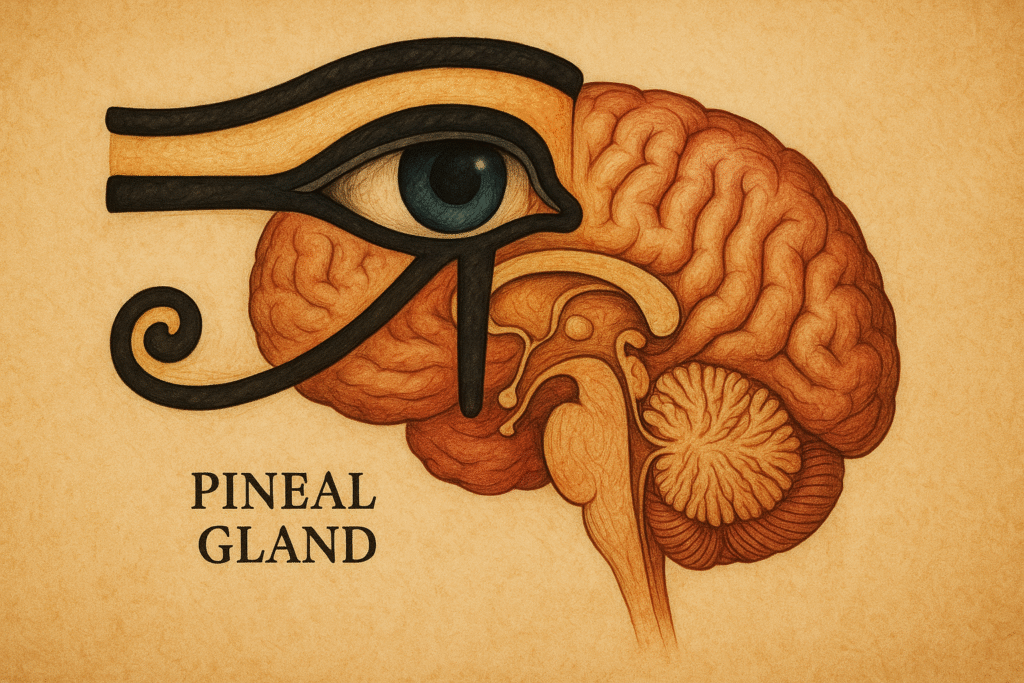For centuries, the Eye of Horus has fascinated people. Some see it as a symbol of protection, while others believe it holds a hidden connection to the brain’s most mysterious organ-the pineal gland function in the brain. Known as the ‘third eye’ in many cultures, the pineal gland is tiny but powerful. It is connected to sleep, mood, and even higher states of awareness.

The idea of the eye of horus pineal gland connection has grown in recent years. Many researchers, spiritual seekers, and historians argue that the ancient Egyptians may have understood something about the pineal gland thousands of years ago.
This article will explore the history, symbolism, science, and spirituality behind this fascinating topic.
What Is the Eye of Horus?
The Eye of Horus is one of the most well-known symbols of ancient Egypt. It is shaped like an eye with markings similar to those of a falcon.
According to Egyptian mythology, the god Horus lost his eye in a battle. Later, it was magically restored, and the eye became a symbol of healing, protection, and restoration.
For the Egyptians, this symbol was more than just art. They believed the Egyptian third eye symbol carried real power. They used it in amulets, jewelry, and temple walls to bring safety, health, and blessings.
Many historians note that the Eye of Horus was linked to vision, knowledge, and spiritual clarity.
This is why today, people often explore the eye of horus spiritual meaning and how it may still guide us in the modern world.
The Pineal Gland Explained
Deep inside the human brain lies a tiny organ, the pineal gland. It is only about the size of a grain of rice, yet it plays a huge role in our daily lives.
Located between the two hemispheres of the brain, this gland controls the production of hormones released by pineal gland, especially melatonin, which regulates sleep and the body’s natural rhythms.
Scientists call it part of the endocrine system. But spiritual traditions call it the third eye-a gateway to higher awareness. French philosopher René Descartes even called it the “seat of the soul.”
Modern science supports at least part of this idea. The pineal gland helps balance sleep cycles, mood, and even hormone production. But some also believe that the gland, when fully activated, may allow people to access states of awareness beyond normal senses.
The pineal gland eye of horus connection is fascinating because the shape of the gland and surrounding brain structures look very similar to the Eye of Horus when viewed in cross-section.
Eye of Horus Pineal Gland Comparison
One of the most debated topics is the eye of horus pineal gland comparison. If you take a cross-section of the human brain and compare it with the Eye of Horus, the similarities are striking.
The lines and shapes of the Egyptian symbol align closely with parts of the thalamus, corpus callosum, and pineal gland.
This has led many to believe that the ancient Egyptians had advanced knowledge of brain anatomy. Some argue that priests and healers in ancient Egypt may have studied the brain during mummification and discovered the pineal gland’s location and importance.
While skeptics say it may just be a coincidence, spiritual traditions see it as evidence that the pineal gland vs the eye of horus connection was intentional.
The Third Eye of Horus – Spiritual Connection
The third eye of horus represents more than physical sight. It represents inner vision, wisdom, and spiritual awakening. In many cultures, the “third eye” is the center of intuition, clarity, and higher consciousness.
For Egyptians, the Eye of Horus may have symbolized not just physical healing but spiritual awakening as well.
The eye of horus meaning spiritual suggests protection from negative forces and the ability to see truth beyond illusion.
In modern spiritual practices, people connect the pineal gland to meditation, dreams, and mystical experiences. When people talk about “opening the third eye,” they often mean awakening the pineal gland to its full potential.
Pineal Gland as an Egyptian Symbol
Why do so many people call the pineal gland an Egyptian pineal gland? Because the Eye of Horus appears to be a pineal gland Egyptian symbol hidden in plain sight.
When you place the Eye of Horus over the anatomy of the brain, the pineal gland sits right in the center of the eye. This suggests the Egyptians may have seen it as the key to inner sight and spiritual perception.
Some historians believe the symbol was used to teach about health and balance. Others believe it was spiritual coding, a way to represent the gateway to divine wisdom.
Pineal Gland and Higher Awareness
The pineal gland does more than regulate sleep. Many believe it is the doorway to higher awareness. When people practice meditation, breathwork, or visualization, they often feel a tingling sensation in the forehead area-commonly linked to the pineal gland.
Spiritual teachers say that when the pineal gland is “activated,” people may experience vivid dreams, deep intuition, or even mystical visions. In many cultures, this has been described as opening the “third eye.”
Even though science does not confirm all spiritual claims, it does show that the pineal gland is sensitive to light, darkness, and chemical changes in the body. This makes it unique among brain structures and may explain why so many cultures gave it deep meaning.
Pineal Gland Calcification – A Modern Problem
There is, however, a challenge in today’s world. Many people suffer from pineal gland calcification. This happens when calcium deposits build up in the gland, making it less active.
According to scientific studies, calcification can start early in life and increase with age. Fluoride in water, poor diet, and lack of sunlight are often linked to this process.
A calcified pineal gland can reduce melatonin production, disrupt sleep, and possibly affect mood and overall health.
In spiritual traditions, a calcified pineal gland is believed to block higher awareness and reduce intuition. For people who connect the eye of horus pineal gland to awakening, this is seen as a major obstacle.
Science vs Spirituality – Bridging the Gap
The debate about the eye of horus pineal gland connection often falls between two worlds-science and spirituality.

On one hand, researchers see the pineal gland as a biological organ that controls sleep and hormones. On the other hand, spiritual traditions see it as the “third eye,” a mystical center of higher awareness.
Modern neuroscience does not confirm all spiritual claims, but it does not deny them either. For example, studies show the pineal gland is light-sensitive.
This makes it unique, because it is like an inner eye, responding to light and darkness even though it is deep inside the brain.
This is why many people believe the ancient Egyptians may have represented it with the Eye of Horus-as both a physical and spiritual symbol. Whether by design or coincidence, the pineal gland vs eye of horus connection sparks questions that remain unanswered.
Spiritual Practices for Activating the Third Eye
The idea of the third eye of horus still lives on today. Many spiritual seekers practice ways to “activate” the pineal gland and awaken their inner vision. Some common methods include:
- Meditation – Focusing on the area between the eyebrows while breathing slowly can help calm the mind and bring awareness to the pineal gland.
- Visualization – Some traditions imagine light entering the forehead, symbolically awakening the third eye.
- Breathwork – Deep, rhythmic breathing exercises are believed to energize the brain and stimulate the pineal gland.
- Chanting and Sound – Vibrations from chants such as “Om” are said to resonate with the gland’s location.
These practices are not just mystical. They also help reduce stress, improve focus, and balance emotions-benefits supported by modern science.
How to Support Pineal Gland Health
The ancient Egyptians may have relied on symbols like the Eye of Horus. But today, we also have practical tools to keep the pineal gland healthy. Here are some ways:
1. Get More Sunlight
Sunlight helps regulate melatonin and serotonin, two hormones linked to mood and sleep. Natural light exposure keeps the pineal gland in rhythm with day and night cycles.
2. Avoid Excess Fluoride
Some studies suggest fluoride may contribute to pineal gland calcification. Drinking clean, filtered water can help reduce the risk.
3. Eat a Nutrient-Rich Diet
Foods high in antioxidants, iodine, and magnesium may protect the gland from calcification. Leafy greens, nuts, seeds, and seaweed are good examples.
4. Reduce Artificial Light at Night
Blue light from phones and screens disrupts melatonin production. Turning off devices before bed or using blue-light filters supports pineal gland function.
5. Practice Mindfulness
Stress can interfere with hormone balance. Meditation and mindfulness keep the mind calm and the gland active.
By combining these lifestyle choices with ancient wisdom, people aim to protect their pineal gland and keep the “third eye” open.
Eye of Horus Spiritual Meaning Today
The eye of horus meaning spiritual is still powerful in modern times. People wear it as jewelry, tattoos, or talismans, believing it offers protection, healing, and clarity.
In meditation groups, the Eye of Horus is often used as a symbol of the egyptian pineal gland connection, reminding practitioners to seek higher truth and balance. For some, it represents awakening. For others, it is simply a reminder of human resilience and inner strength.
Either way, the symbol has survived for thousands of years, showing that its meaning is still relevant.
The Mystery of Ancient Knowledge
One of the most fascinating questions is this: Did the Egyptians really know about the pineal gland? Or is the similarity between the Eye of Horus and brain anatomy just coincidence?
Supporters of the pineal gland Egyptian symbol theory argue that the Egyptians’ advanced knowledge in medicine, mathematics, and architecture suggests they could have studied the human brain closely.
During mummification, they removed organs and may have noticed the pineal gland’s unique position.
Skeptics argue that while the resemblance is interesting, there is no direct evidence that the Egyptians linked the Eye of Horus with the pineal gland.
Still, the mystery keeps the debate alive. And perhaps that is part of the symbol’s power-it invites us to keep questioning and searching for truth.
Modern Interest in the Pineal Gland
Today, interest in the eye of horus pineal gland is growing. From scientific studies about melatonin to spiritual practices about the third eye, people around the world want to understand this tiny gland better.
Even wellness industries now promote pineal gland detox, supplements, and courses on “third eye activation.” While not all claims are backed by science, the fascination shows how strongly people connect with the idea of hidden inner power.
This blend of science and spirituality reflects the same mystery the Eye of Horus carried thousands of years ago.
Conclusion
The Eye of Horus and the pineal gland form one of the most intriguing bridges between ancient wisdom and modern science. Whether you see the eye of horus pineal gland as a coincidence, symbolism, or hidden knowledge, its message remains clear: there is more to human awareness than meets the eye.
The Eye of Horus symbolized protection, healing, and inner sight for the Egyptians. The pineal gland regulates sleep, mood, and maybe even deeper states of awareness for us today. Together, they remind us of the connection between body, mind, and spirit. So next time you see the Egyptian third eye symbol, think not just of history, but also of the mystery that still lives within your brain-the pineal gland, the modern “third eye.”